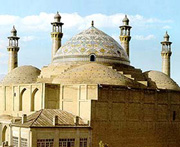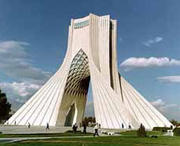|
  
- UID
- 12794
- 帖子
- 8745
- 积分
- 11208
- 学分
- 55197 个
- 金币
- 800 个
- 在线时间
- 795 小时

|
|
Tehran (Iran) |  Iran is not blessed with one of the world's loveliest capitals. Pollution, traffic snarls, chronic overcrowding(长期过度拥挤)and a lack of responsible planning have all helped to make Tehran a metropolis that even the most effusive travel agent would have difficulty praising. If you're expecting an exotic(异国请调的)crossroads steeped in oriental splendour, you'll be sadly disappointed. The main sights are spread out, but the hotels are good, the variety of restaurants is impressive, the facilities are far ahead of those anywhere in the provinces, and the Tehranis are friendly. Iran is not blessed with one of the world's loveliest capitals. Pollution, traffic snarls, chronic overcrowding(长期过度拥挤)and a lack of responsible planning have all helped to make Tehran a metropolis that even the most effusive travel agent would have difficulty praising. If you're expecting an exotic(异国请调的)crossroads steeped in oriental splendour, you'll be sadly disappointed. The main sights are spread out, but the hotels are good, the variety of restaurants is impressive, the facilities are far ahead of those anywhere in the provinces, and the Tehranis are friendly.
There is no real central area, though many budget travellers base themselves near Emam Khomeini Square in the less appealing south of the city, where there's cheap accommodation, fine kebab(烤肉串)and good access to bus and train transport. Getting lost in Tehran is easy. If you need landmarks, the Alborz mountains, known as the 'North Star' of Tehran, are to the north; and the huge telephone office at Emam Khomeini Square dominates inner southern Tehran. Fortunately, most streets that travellers are likely to take are signposted(给……加路标)in English. Other than that, many streets, such as those around the Tehran Bazaar(德黑兰集市), have no signposts at all.
The best times to visit are during late spring (mid-April to early June) and autumn (late September to early November). Avoid coming in winter and the Iranian New Year (about 21 March) and two weeks after it. Many restaurants close between dawn and dusk during the month of Ramazan(斋月).
 Human settlement of the region dates from Neolithic times(新石器时代), but the development of Tehran was very slow and its rise to prominence largely accidental. In AD 1197, after Mongols(蒙古人)sacked and destroyed nearby Rey - the major urban centre in Persia(波斯)at the time - Tehran began to develop in its place. From the mid-16th century, Tehran's attractive natural setting and good hunting brought it into the favour of the Safavid king, Tahmasb I. It developed from a moderately prosperous trading village into an elegant, if dusty, city, and European visitors wrote of its many enchanting vineyards(葡萄园)and gardens. In 1789, Agha Muhammed Khan declared Tehran his capital, and six years later had himself crowned as shah of all Persia. The town continued to grow slowly under later Qajar rulers. Human settlement of the region dates from Neolithic times(新石器时代), but the development of Tehran was very slow and its rise to prominence largely accidental. In AD 1197, after Mongols(蒙古人)sacked and destroyed nearby Rey - the major urban centre in Persia(波斯)at the time - Tehran began to develop in its place. From the mid-16th century, Tehran's attractive natural setting and good hunting brought it into the favour of the Safavid king, Tahmasb I. It developed from a moderately prosperous trading village into an elegant, if dusty, city, and European visitors wrote of its many enchanting vineyards(葡萄园)and gardens. In 1789, Agha Muhammed Khan declared Tehran his capital, and six years later had himself crowned as shah of all Persia. The town continued to grow slowly under later Qajar rulers.
From the early 1920s, the city was extensively modernised on a grid system, and this period marked the start of phenomenal population growth and uncontrolled urban development. An educated and cosmpolitan middle class elite, with an open attitude towards Western influence, flourished under the Shah, but the growth of the city began a trickle of poor, rural migrants that soon turned into a flood.
The depopulation(居民减少)of the surrounding regions continues to this day as the rural poor continue to stream into Tehran in ever greater numbers. This migration has put the city's infrastructure under enormous pressures. In 1930 the population was 300,000; in 2001 it was estimated to be 12 million. These pressures often translate into popular revolt, hence Tehran's central role in the Islamic Revolution of 1979 and in more recent protests against the clerical monopolisation of political power.
|
|
|